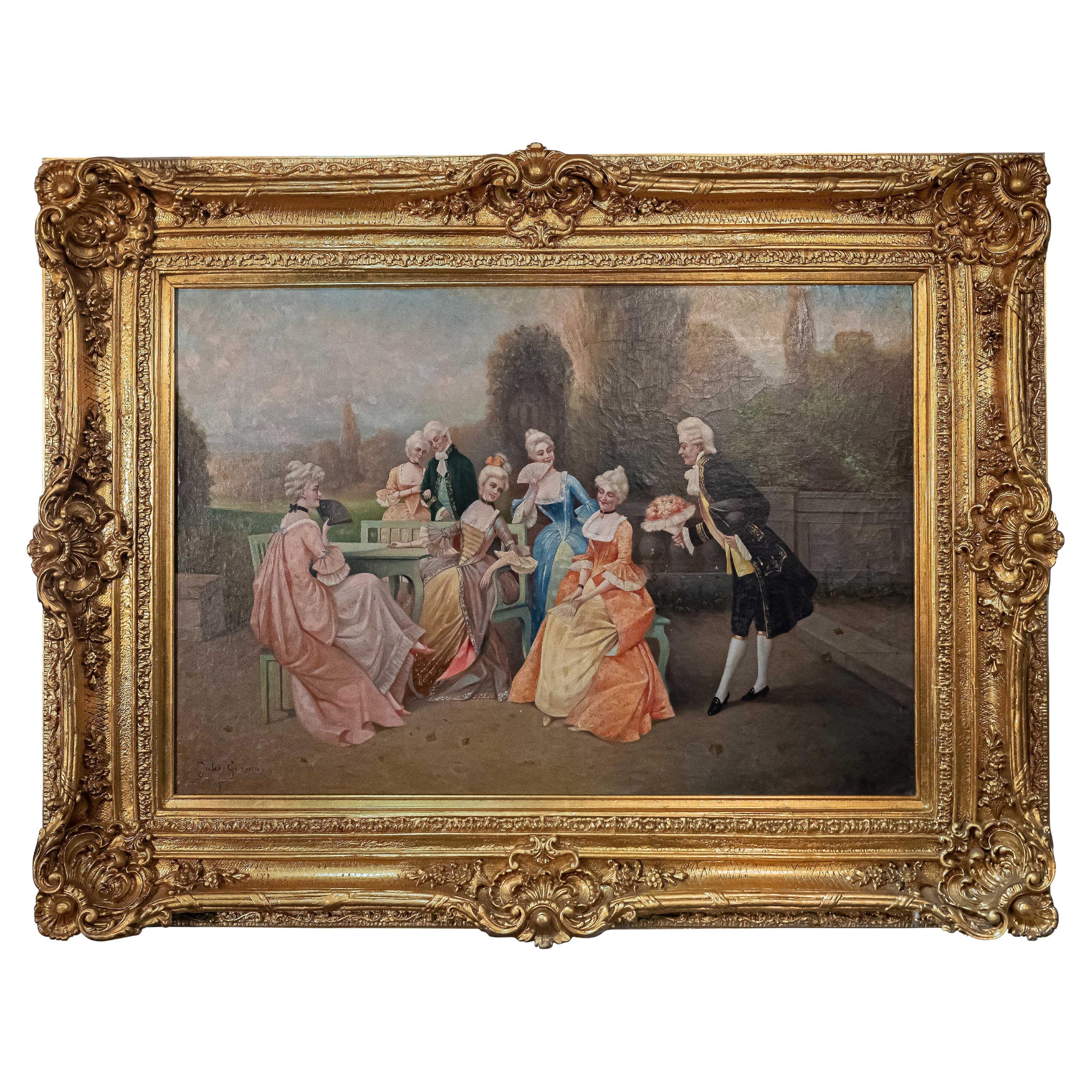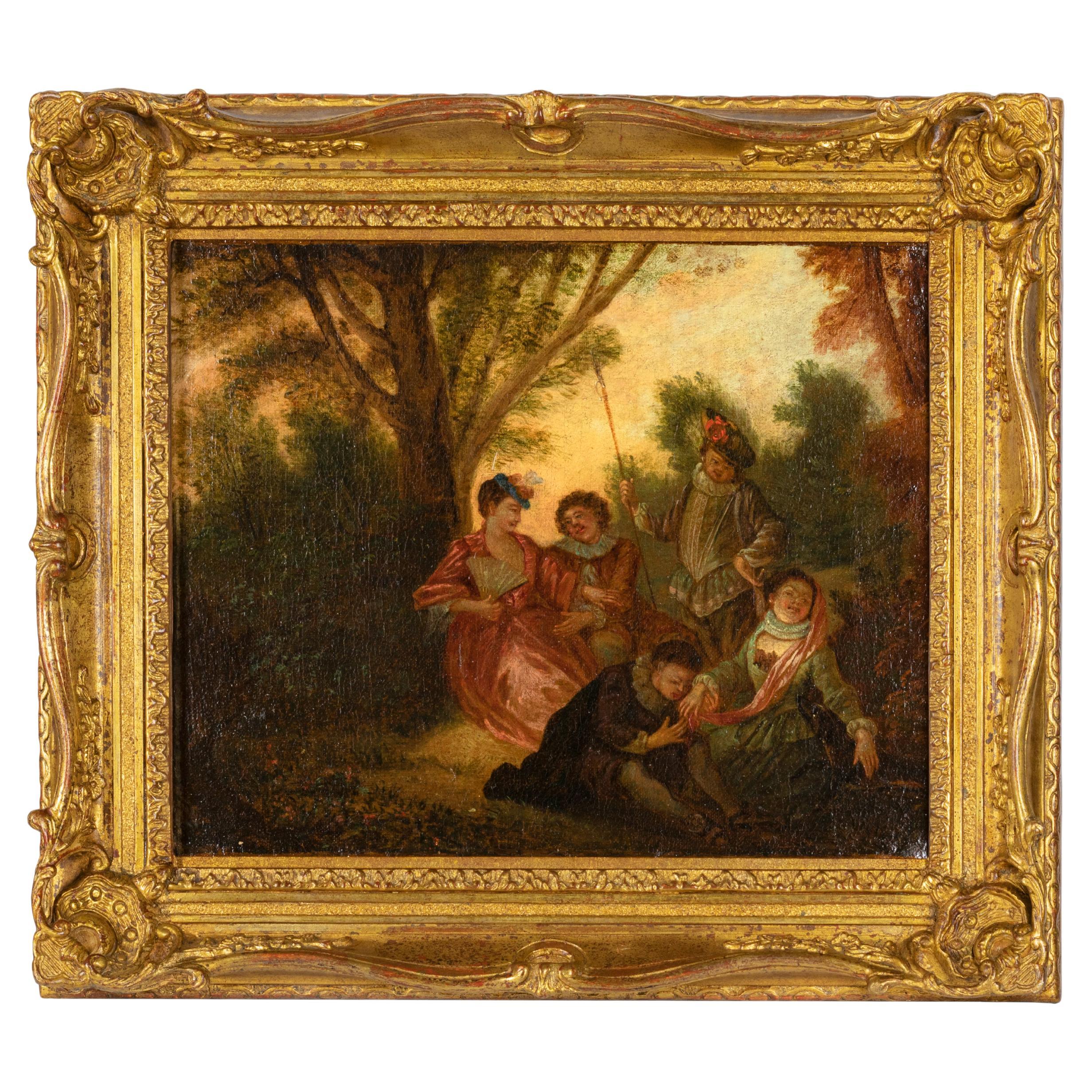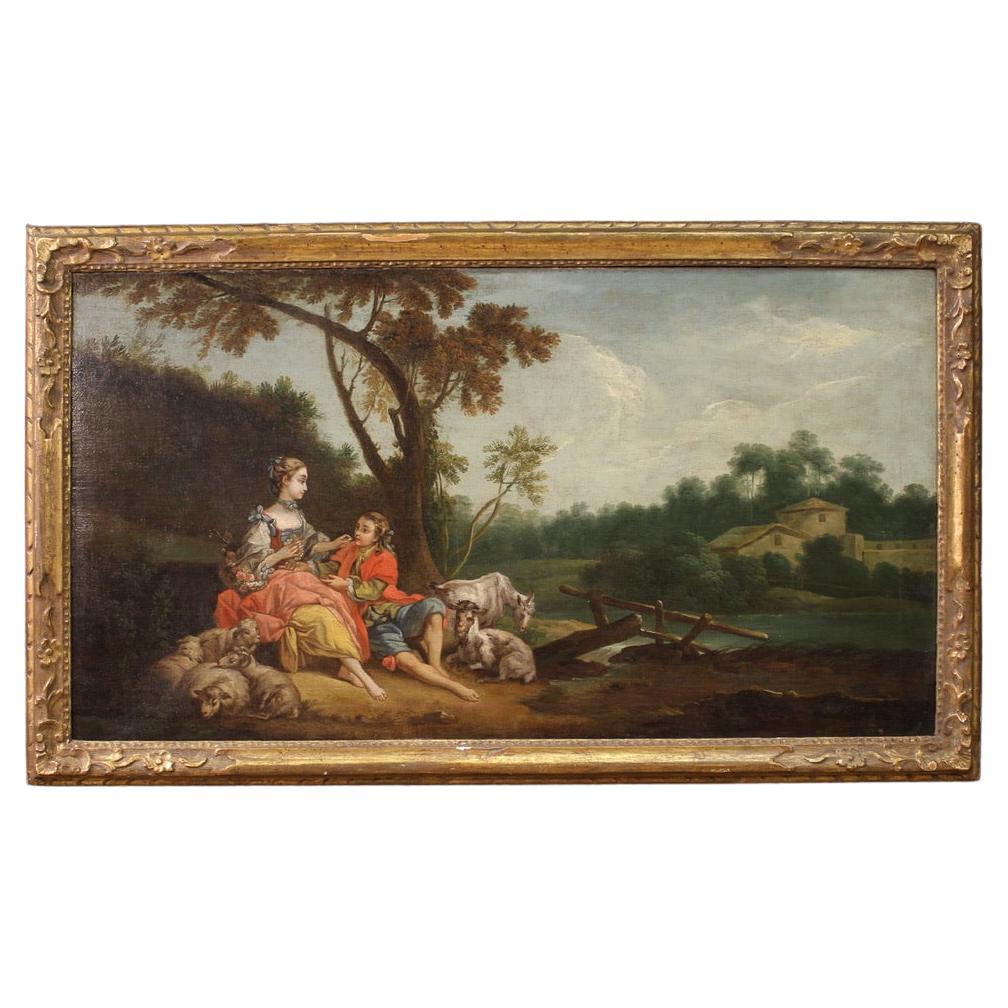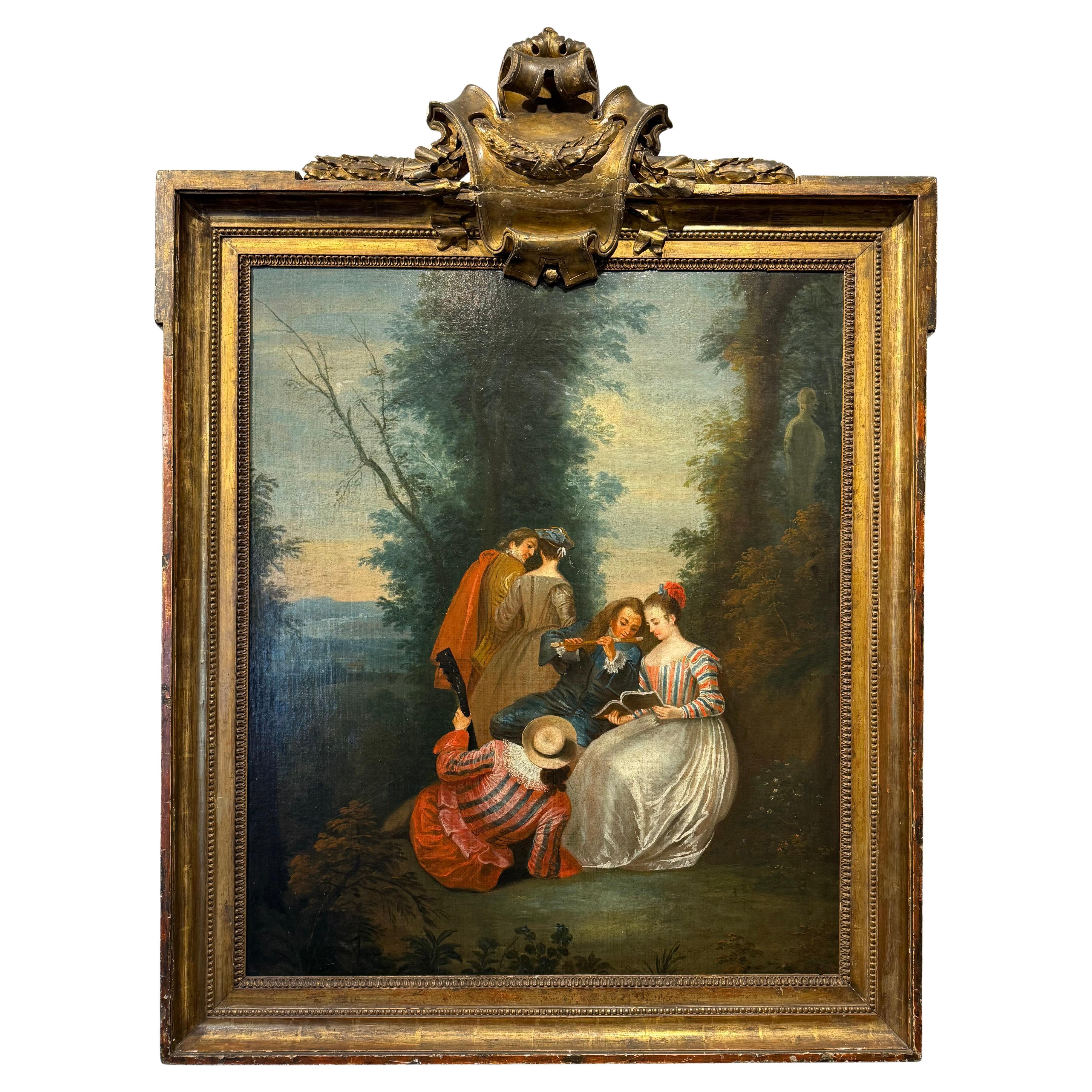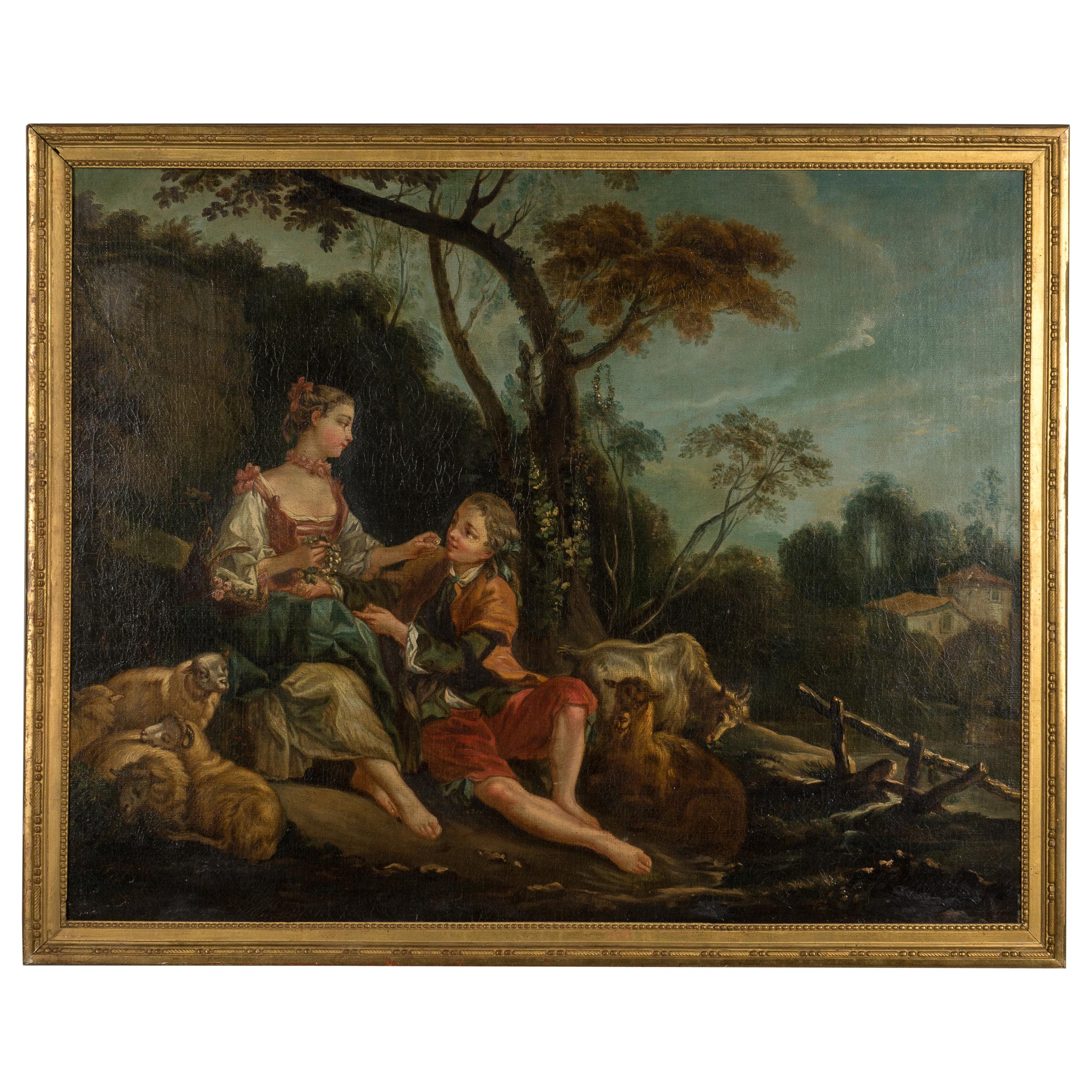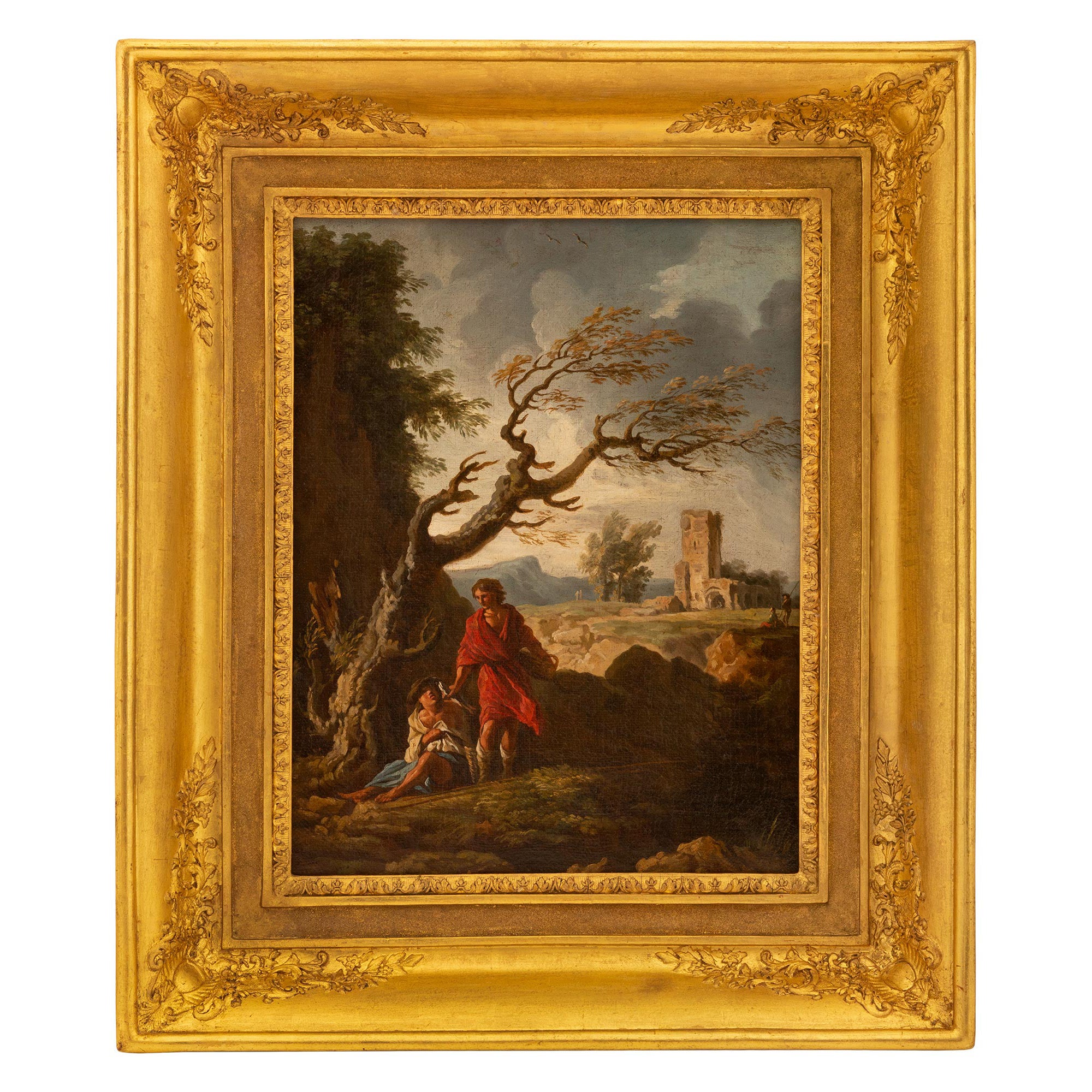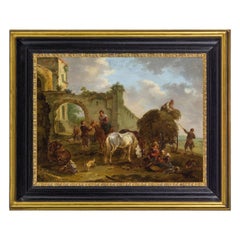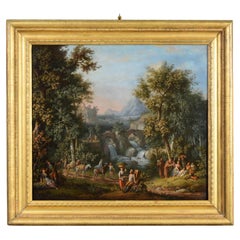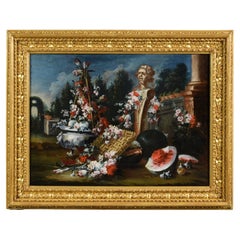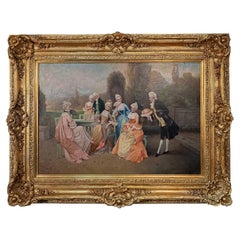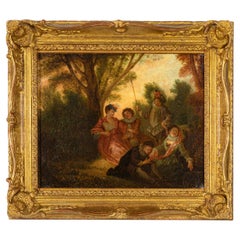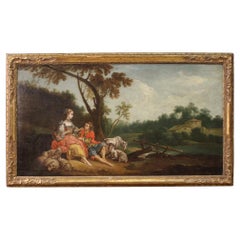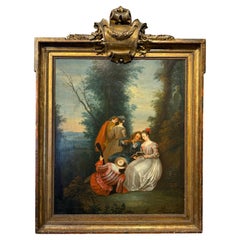Items Similar to 19th Century, French Painting with Blind man's bluff by Nicolas Edward Gabe
Want more images or videos?
Request additional images or videos from the seller
1 of 20
19th Century, French Painting with Blind man's bluff by Nicolas Edward Gabe
$17,747.85
$22,184.8120% Off
£13,202.61
£16,503.2620% Off
€14,800
€18,50020% Off
CA$24,302.87
CA$30,378.5920% Off
A$27,021.49
A$33,776.8620% Off
CHF 14,109.13
CHF 17,636.4120% Off
MX$328,917.32
MX$411,146.6520% Off
NOK 180,026.36
NOK 225,032.9520% Off
SEK 168,676.10
SEK 210,845.1220% Off
DKK 112,664.23
DKK 140,830.2820% Off
Shipping
Retrieving quote...The 1stDibs Promise:
Authenticity Guarantee,
Money-Back Guarantee,
24-Hour Cancellation
About the Item
Nicolas Edward Gabe (Paris, 1814-1865)
Blind man's bluff
Oil on canvas, cm L 72 x W 58 (without frame); with frame cm H 98 x W 84 x D 8
The painting, made in oil on canvas, depicts some nobles in eighteenth-century clothes playing Blind man's bluff in the garden of an aristocratic palace. The work is signed in the lower right "EGabe", as usual left his name the French painter Nicolas Edward Gabe (Paris, 1814-1865). It is a 19th century painting clearly inspired by the French Rococo models of the eighteenth century, both for the stylistic choice and, as we will see, for the subject.
Nicolas Edward Gabe lived and was active in Paris and France and specialized in painting portraits, figures, historical scenes and landscapes. He used different techniques, from the more traditional oil on canvas, to oil on board and on copper or watercolor on paper, as several works that survive today prove.
There are almost no studies of his life and professional fortune. However, the discovery of several of his works, signed and often dated, allow today to outline his artistic figure.
Several of his works fully express the taste and sensitivity that developed in the first half of the nineteenth century in France. Gabe was in fact an exponent of that historical Romanticism that saw depict the different political, social and industrial struggles that marked the century, or historical episodes of military chronicle, but also portraits and descends of gender. Influenced by the continuous unrest under Napoleon III and the restoration of the monarchy, Gabe developed, like many other contemporary artists, an emphasis on emotion and the glorification of the more romantic past, towards the recovery of eighteenth-century Rococo models. This style tended to reproduce the typical feeling of aristocratic, idle, worry-free life or that of the light novel. In the painting he liked very much the gallant scene, aristocratic variant of the genre scene, representing women engaged in the toilet, in boudoirs or in hedonistic rites that become the symbol of a more savvy and worldly vision of art.
Painters used delicate colors and curved shapes to express the value of grace and lightness.
Among the major exponents, for painting, we should mention Jean-Antoine Watteau, François Boucher, Jean-Marc Nattier and Jean-Baptiste Pater.
Gabe was inspired several times by their works, proposing in his paintings subjects and style typically Rococo.
The subject of the dance in the park and especially of the game of the Blind man's bluff was often depicted in eighteenth-century painting, as it well represented the Blind man's bluff is a game of ancient origin and dates back to the time of Ancient Rome, although the sources are always very contrasting. It is a variation of another famous outdoor game which spread to Victorian England. It was widely practiced by the nobility in 18th-century France. The game was only a viaticum of the love relationship, a pretext to promote the romantic relationships among the young people of the time. The Blind man's bluff of the nobles of the eighteenth century could also be played with only two players, in which one was blindfolded and the other the competitor to be captured.
The purpose was therefore only to create an approach between a probable couple of lovers. On the other hand, the eighteenth-century playful world was clever, full of tricks and deceptions. The nobles spent their time in trivial games such as Blind man's bluff, chess or hunting in parks. In this way, the nobility of the Ancien Regime, living at court, was deliberately distracted and removed from political life, whose choices were the prerogative of the absolute monarchy.
The comparison of Gabe’s canvas object of this study with some works by Jean-Baptiste Pater (Valenciennes, 29 December 1695 - Paris, 25 July 1736) highlights the sources of inspiration to which the nineteenth-century author looked.
We apologize for any translation errors. Please contact to have the expertise in Italian.
- Dimensions:Height: 38.59 in (98 cm)Width: 33.08 in (84 cm)Depth: 3.15 in (8 cm)
- Style:Rococo (In the Style Of)
- Materials and Techniques:
- Place of Origin:
- Period:
- Date of Manufacture:19th Century
- Condition:Wear consistent with age and use.
- Seller Location:IT
- Reference Number:1stDibs: LU4405237117442
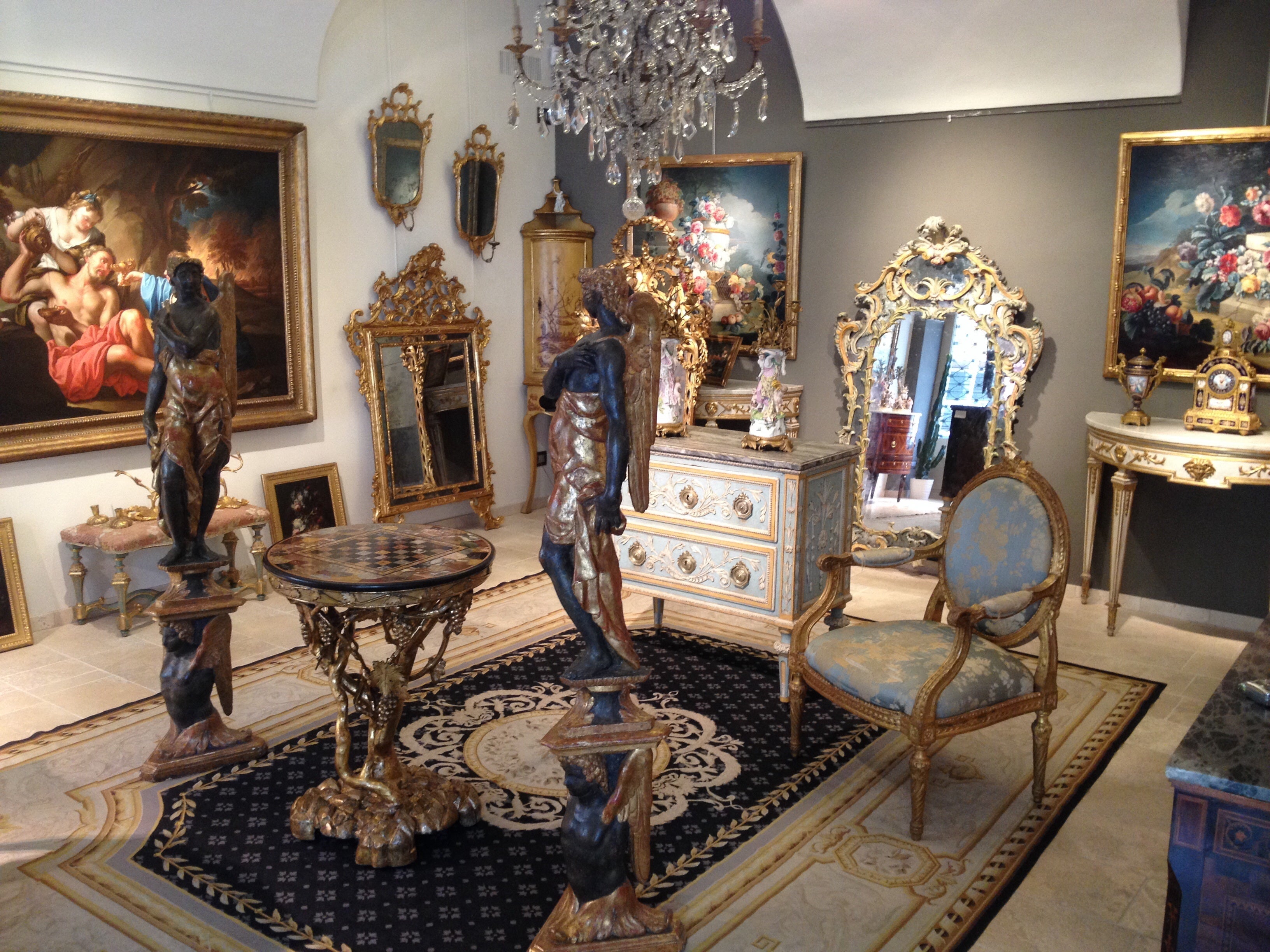
About the Seller
5.0
Platinum Seller
Premium sellers with a 4.7+ rating and 24-hour response times
Established in 1980
1stDibs seller since 2019
56 sales on 1stDibs
Typical response time: 1 hour
- ShippingRetrieving quote...Shipping from: Italy
- Return Policy
Authenticity Guarantee
In the unlikely event there’s an issue with an item’s authenticity, contact us within 1 year for a full refund. DetailsMoney-Back Guarantee
If your item is not as described, is damaged in transit, or does not arrive, contact us within 7 days for a full refund. Details24-Hour Cancellation
You have a 24-hour grace period in which to reconsider your purchase, with no questions asked.Vetted Professional Sellers
Our world-class sellers must adhere to strict standards for service and quality, maintaining the integrity of our listings.Price-Match Guarantee
If you find that a seller listed the same item for a lower price elsewhere, we’ll match it.Trusted Global Delivery
Our best-in-class carrier network provides specialized shipping options worldwide, including custom delivery.More From This Seller
View All18th Century, Italian Painting Depicting Landscape with Watermill and Characters
Located in IT
18th century, Italian painting depicting landscape with watermill and characters
Oil on canvas; Measurements: frame cm L 103.5 x H 127 x P 5; painting L 93 x H 117.5
The painting...
Category
Antique Mid-18th Century Italian Rococo Paintings
Materials
Canvas
18th Century, Baroque Austran Painting by August Querfurt
Located in IT
August Querfurt (1696, Wolfenbüttel - 1761, Vienna)
Farmers and villagers at the entrance of a village
Oil on panel , cm 38,5 x 51. frame 66 x 53,5 x 4,5 cm
The valuable painting, ...
Category
Antique 18th Century Austrian Baroque Paintings
Materials
Wood
18th Centuy, Italian Painting with Landscape by Giovanni Battista Colomba
Located in IT
Giovanni Battista Innocenzo Colomba (1713 – 1793)
Landscape with figures
Oil on canvas, Frame H 102 x L 112 x P 8; canvas H 77 x L 87
The valuable painting, attributable to the pai...
Category
Antique Mid-18th Century Italian Rococo Paintings
Materials
Canvas
$22,064 Sale Price
20% Off
18th Century, Italian Still Life Painting Attributed to Francesco Lavagna
By Francesco Lavagna
Located in IT
Francesco Lavagna (Italy -Naples 1684-1724)
"Still life with flowers and watermelon and hermas with garden in the background"
The painting, beautifully made and in good condition, d...
Category
Antique Early 18th Century Italian Baroque Paintings
Materials
Canvas
$17,747 Sale Price
20% Off
17th Century, Italian Painting by Pier Francesco Cittadini, Jacob and his Family
Located in IT
Pier Francesco Cittadini (Milan, 1616-Bologna, 1681)
"Jacob and his family go to Egypt"
Oil on canvas, cm 109 x 190 (canvas only)
The valuable painting, made in oil on canvas, depicts Jacob and his family go to Egypt and we believe it can be, given the high quality painting, autograph work of Italian Pier Francesco Cittadini (Italy Milan, 1616 - Bologna, 1681) made after 1647. The work, in excellent condition is accompanied by a coeval frame in wood finely carved and golden.
The scene depicted, which was confused with the Flight to Egypt in the past years, is instead identified with the biblical episode of Jacob’s journey. In the foreground, reading the painting from left to right, we see a caravan composed of animals, including donkeys, dromedaries, goats, dogs and horses and people, women, men and slaves, who carry on their journey along the banks of a river, following a path that to the right, would seem to lead to the through of a bridge. In addition to the watercourse is described an environment characterized by large rocks and impervious come far to cover the entire verticality of the canvas. On the left, in the distance, we see the tail of the caravan that runs along the steep path. Large trees enliven and harmonize the environment, as well as white and grey clouds characterize the predominantly clear sky and illuminated on the right by sunlight.
The story is told in the Bible, Book of Genesis, 30, 25, passage in which is described the flight of Jacob from Haran after the contrasts with Laban, father of his wife Rachel. Jacob is the third great patriarch of the Bible. From his descendants originate the twelve generations of the people of Israel. He is the son of Isaac and Rebekah, who led him to flee from the wrath of Esau to Haran to seek refuge from his brother, Laban. At his uncle’s house Jacob met his daughter Rachel. As soon as he saw his cousin, Jacob was taken. Jacob will stay seven years in the service of Laban to marry his beloved Rachel. But Laban, with a deception, will give him in marriage first Lia, the least beautiful eldest daughter, and only after another seven years the splendid Rachel. From his first wife he will have several children, while Rachel will give birth to the beloved son, Joseph, who will become viceroy of Egypt.
After years of service, Jacob asked to be paid with every dark-coloured garment among the sheep and every spotted and dotted garment among the goats. Laban accepted and sent away from his sons all the leaders of that kind. So Jacob took fresh branches of poplar, almond and plane tree, and flayed them, and put them in the troughs. The optical suggestion induced the goats and the sheep to conceive and give birth to dark, striped and dotted garments. He also ensured that all the strongest and healthiest leaders of the flock of Laban would drink near the barked branches, thus assuring a genetic superiority to his part of the flock. His flocks grew numerous and strong and he became richer than his relative, arousing envy. It was clear that Laban would not respect him much longer. At the suggestion of the Lord, Jacob decided to return to Canaan. Trying to avoid any possible dispute, he left with his family while Laban was absent for shearing sheep. But when, three days later, his uncle returned home, he became angry, feeling offended because Jacob had gone secretly and had not allowed him to greet his daughters and grandchildren. In addition, his teraphim, statuettes, or idols, which depicted the family deities, had disappeared. After 7 days of pursuit, Laban and his men reached Jacob’s group on Mount Gilead, in the mountainous region west of the Euphrates River, where his uncle and grandson had a stormy conversation. The younger man was outraged at being accused of stealing idols and told Labano to rummage through his family’s tents at will. Neither of them could know or even imagine that it was Rachel who took the idols and hid them in the saddle of the camel. During the search, she sat down firmly on the saddle, apologizing for not being able to get up, «because I usually have what happens to women» (Gen 31:35). So the loot wasn’t discovered.
The author of this work was inspired by the composition of an engraving by Stefano Della Bella (1610-1664) of circa 1647. The engraving by Stefano della Bella bears the title "Iacob sur ses vieux jours quitte sans fascherie pour voir son filz Ioseph, sa terre et sa patrie" and is signed on the bottom left "Stef. of the Beautiful In. et fe." while on the right it is declared "Cum privil. Regis", that is with license of the king.
Stefano Della Bella (Italy - Florence, May 18, 1610-Florence, July 12, 1664) was born in a family of painters, sculptors and goldsmiths and was left early orphan of his father sculptor, he dedicated himself first to the art of goldsmith at the school of Giovanni Benedetto Castiglione and Gasparo Mola, then turning his attention to drawing and engraving. He soon began drawing figures and copying the etchings of Jacques Callot, which inspired his early works. Under the protection of the Medici, in particular of Don Lorenzo, cadet son of Grand Duke Ferdinand I, Della Bella has the opportunity to make study trips to Rome, where he stayed from 1633-1636; In Rome he met French engravers and publishers of prints such as Israël Henriet and François Langlois, who influenced his decision to move to Paris in 1639, four years after the death of Callot. In Paris he soon reached, thanks to the engravings commissioned by Cardinal Richelieu, the success also worldly; he frequented courtiers, theatre artists and writers, while refusing too oppressive honors. In 1646-1647 he continued his travels in the Netherlands to Amsterdam, Antwerp and Dordrecht. He returned to Florence in 1650 and resumed working under the protection of the Medici court, working for his patrons. In 1656 he became a member of the Academy of Apatists.
The painting object of this study is reasonably attributable to Pier Francesco Cittadini, or Pierfrancesco Cittadini, called the Milanese or the Franceschino (Italy - Milan, 1616-Bologna, 1681) as some exemplary stylistic comparisons proposed to follow can prove.
Pier Francesco Cittadini was an Italian baroque painter, mainly active in Bologna.
His artistic training first took place with the painter Daniele Crespi...
Category
Antique Mid-17th Century European Baroque Paintings
Materials
Canvas, Giltwood
18th Century, Painting Architectural Capriccio, att. to Isaac De Moucheron
Located in IT
18th Century, Painting with Architectural Capriccio with figures, attributed to Isaac De Moucheron
Measures: canvas cm H 108 x L 152; with frame cm H 132 x L 176 x 8
The painting i...
Category
Antique 18th Century Dutch Baroque Paintings
Materials
Canvas
You May Also Like
Large 19th Century French Oil on Canvas by Jules Garson
Located in Los Angeles, CA
A 19th century French oil painting on canvas depicting classical figures in landscape, with a standing gentleman presenting bouquet of flowers to a sitting lady.
Signed: Jules Garson...
Category
Antique Late 19th Century French Paintings
Materials
Canvas
Gallant Scene Painting by Philippe Mercier, 18th Century
Located in Lisbon, PT
An 18th century painting of a gallant scene in a park.
Attributed with seal of painter's studio to Philippe Mercier (1689 to 1760) from the circle of the french painter Nicolas Lanc...
Category
Antique 18th Century French Baroque Paintings
Materials
Canvas, Wood
$9,148 Sale Price
20% Off
18th Century Oil on Canvas French Antique Rococo Gallant Scene Painting, 1750
Located in Vicoforte, Piedmont
Splendid French painting from the 18th century. Oil on canvas artwork depicting a wonderful rural scene in the Rococo style with young people and grazing animals, of remarkable picto...
Category
Antique 1750s French Paintings
Materials
Canvas
A Large French Wooden Framed Oil Painting on Canvas, 18th Century
By (After) Jean-Honoré Fragonard
Located in ARMADALE, VIC
A Large French Wooden Framed Oil Painting on Canvas, 18th Century
(After) the school of Jean-Honoré Fragonard
Provenance: Private Melbourne Collection.
Dimensions:
Height: 140cm.
W...
Category
Antique 18th Century French Paintings
Materials
Canvas, Wood
18th Century French Oil Painting
Located in Winter Park, FL
A late 18th century French painting depicting a romantic couple in a pastoral setting. Oil on canvas. Unsigned. Original gilded wood frame. Small repair to canvas in the upper left c...
Category
Antique Late 18th Century French French Provincial Paintings
Materials
Giltwood, Paint
Continental 18th Century Oil on Canvas Painting in Its Original Giltwood Frame
Located in West Palm Beach, FL
An exceptional and extremely decorative Continental 18th century oil on canvas painting in its original giltwood frame. The wonderfully executed painting depicts a handsome young man...
Category
Antique 18th Century Unknown Paintings
Materials
Canvas, Giltwood
More Ways To Browse
French Military Paintings
Italian Rococo Painting
Toilet Italian
Antique Victorian Toilets
Victorian Toilet
Painted Toilet
Hand Painted Toilet
Jean Marc Nattier
Copper Toilet
Jean Baptiste Pater
Chess Garden
Antique Shiva
Antique Slant Top Writing Desk
Antique Wedgwood Bowl
Art Deco Cabinet Bakelite
Art Deco Vintage Cigarette Case
Asian Black Lacquer Pearl Furniture
Asian Tall Cabinets
